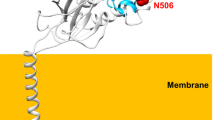Abstract
The generation of an acidic pH in intracellular organelles is required for several membrane and protein recycling processes. For instance, the internalization of ligands by receptor-mediated endocytosis is followed by the development of an acidic pH inside endosomes; this allows dissociation of the ligand, which is then transported to the lysosomes, from the receptor, which is recycled to the cell surface1–4. There is evidence that part of this recycling process involves the distal region of the Golgi complex, where terminal glycosylation occurs: when the plasma membrane transferrin receptor is desialylated by neuraminidase treatment, it acquires new sialic acid molecules after endocytosis and before cell-surface re-expression5. Golgi membranes have been shown to contain a proton pump6 and the distal Golgi cisternae appear to have an acidic content7. Here, we have studied the effects of chloroquine and ammonium chloride, which raise the pH of acidic intracellular compartments8, on the processing and secretion of immunoglobulins by plasma cells. Sialic acid transfer to terminal galactose residues, a reaction known to occur in the distal Golgi shortly before secretion9, is completely and rapidly inhibited in the presence of these drugs, without significant modification of the secretion rate. This effect is accompanied by a dilatation of the Golgi cisternae and is not rapidly reversible.
This is a preview of subscription content, access via your institution
Access options
Subscribe to this journal
Receive 51 print issues and online access
$199.00 per year
only $3.90 per issue
Buy this article
- Purchase on Springer Link
- Instant access to full article PDF
Prices may be subject to local taxes which are calculated during checkout
Similar content being viewed by others
References
Brown, M. S., Anderson, R. G. W. & Goldstein, J. L. Cell 32, 663–667 (1983).
Tycko, B., Keith, C. H. & Maxfield, F. R. J. Cell Biol. 97, 1762–1776 (1983).
Schwartz, A. L., Bolognesi, A. & Fridovich, S. E. J. Cell Biol. 98, 732–738 (1984).
Harford, J., Wolkoff, A. W., Ashwell, G. & Klausner, R. D. J. Cell Biol. 96, 1824–1828 (1983).
Snider, M. D. & Rogers, O. C. J. Cell Biol. 100, 826–834 (1985).
Glickman, J., Croen, K., Kelly, S. & Al-Awqati, Q. J. Cell Biol. 97, 1303–1308 (1983).
Anderson, R. G. W. & Pathak, R. K. Cell 40, 635–643 (1985).
de Duve, C. et al Biochem. Pharmac. 23, 2495–2534 (1974).
Tartakoff, A. & Vassalli, P. J. Cell Biol. 83, 284–299 (1979).
Chicheportiche, Y., Vassalli, P. & Tartakoff, A. M. J. Cell Biol. 99, 2200–2210 (1984).
Bretz, R., Bretz, H. & Palade, G. E. J. Cell Biol. 84, 87–101 (1980).
Basu, S. K., Goldstein, J. L., Anderson, R. G. W. & Brown, M. S. Cell 24, 493–502 (1981).
Tartakoff, A. & Vassalli, P. J. exp. Med. 146, 1332–1345 (1977).
Dunphy, W. G. & Rothman, J. E. J. Cell Biol. 97, 270–275 (1983).
Roth, J. & Berger, E. G. J. Cell Biol. 97, 270–275 (1983).
Roth, J., Lucocq, J. & Charest, P. M. J. Histochem. Cytochem. 32, 1167–1176 (1984).
Roth, J., Taatjes, D. J., Lucocq, J. M., Weinstein, J. & Paulson, J. C. Cell 43, 287–295 (1985).
Anderson, J., Coutinho, A., Lenhardt, W. & Melchers, F. Cell 10, 27–34 (1977).
Thorens, B., Schulz, M.-F. & Vassalli, P. EMBO J. 4, 361–368 (1985).
O'Farrel, P. H. J. biol. Chem. 250, 4007–4021 (1975).
Author information
Authors and Affiliations
Rights and permissions
About this article
Cite this article
Thorens, B., Vassalli, P. Chloroquine and ammonium chloride prevent terminal glycosylation of immunoglobulins in plasma cells without affecting secretion. Nature 321, 618–620 (1986). https://doi.org/10.1038/321618a0
Received:
Accepted:
Issue Date:
DOI: https://doi.org/10.1038/321618a0
This article is cited by
-
Hypercapnia slows down proliferation and apoptosis of human bone marrow promyeloblasts
Bioprocess and Biosystems Engineering (2016)
-
Therapy and pharmacological properties of hydroxychloroquine and chloroquine in treatment of systemic lupus erythematosus, rheumatoid arthritis and related diseases
Inflammopharmacology (2015)
-
Reduced glutamine concentration improves protein production in growth-arrested CHO-DG44 and HEK-293E cells
Biotechnology Letters (2012)
-
Lysosomotropic agents as HCV entry inhibitors
Virology Journal (2011)
-
Inhibition of hepatitis C virus replication by chloroquine targeting virus-associated autophagy
Journal of Gastroenterology (2010)
Comments
By submitting a comment you agree to abide by our Terms and Community Guidelines. If you find something abusive or that does not comply with our terms or guidelines please flag it as inappropriate.



